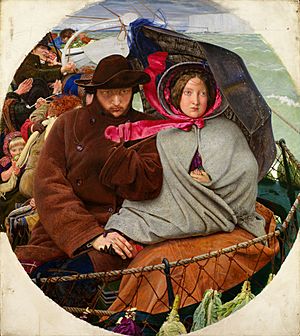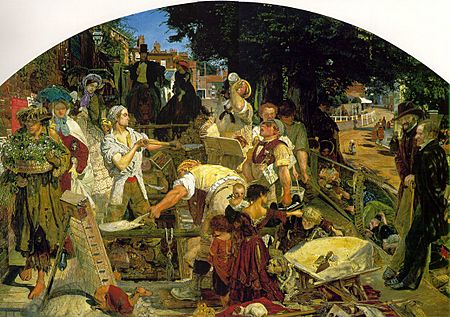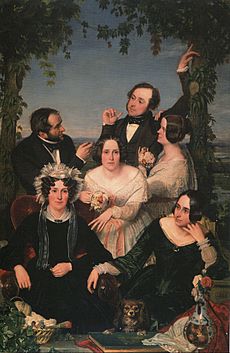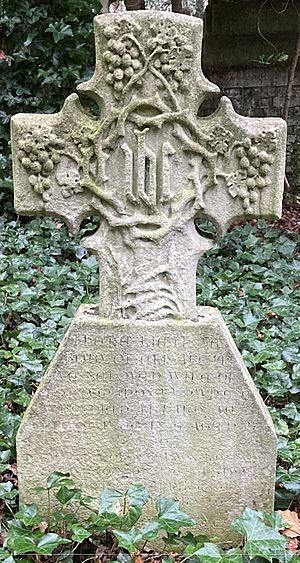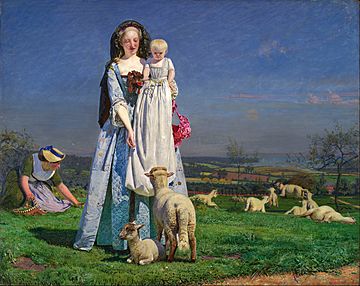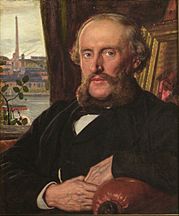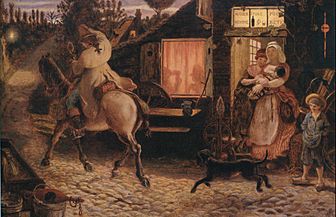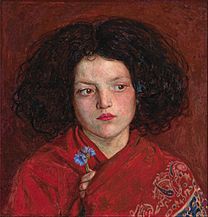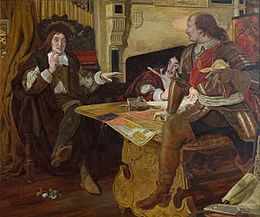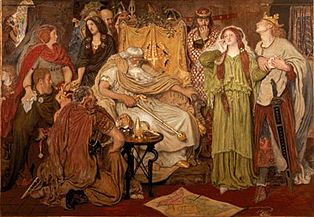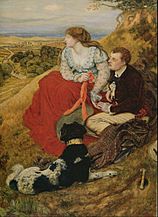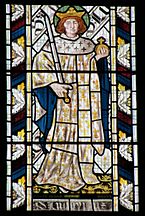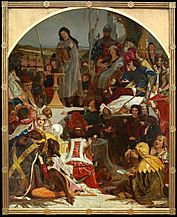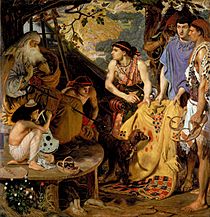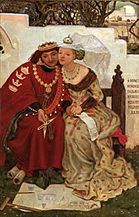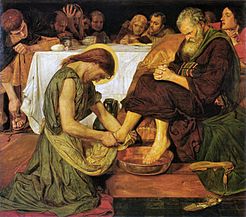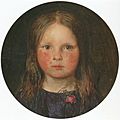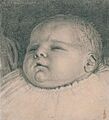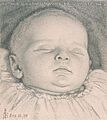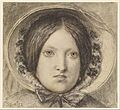Ford Madox Brown facts for kids
Quick facts for kids
Ford Madox Brown
|
|
|---|---|
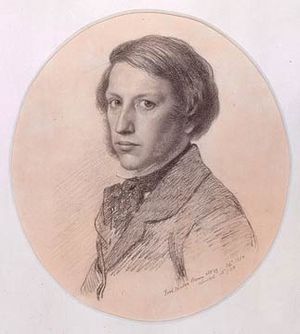
Self-portrait 1850
|
|
| Born | 16 April 1821 Calais, France
|
| Died | 6 October 1893 (aged 72) London, England
|
| Resting place | St Pancras and Islington Cemetery |
| Nationality | British |
| Known for | Painting |
|
Notable work
|
Work (painting) The Last of England (painting) |
| Movement | Pre-Raphaelite |
| Spouse(s) |
Elizabeth Bromley
(m. 1841; died 1846)Emily Hill
(m. 1853; died 1890) |
Ford Madox Brown (born April 16, 1821 – died October 6, 1893) was a British painter. He was known for his unique style, which was part of the Pre-Raphaelite art movement. He often painted scenes from history and everyday life that taught a lesson.
One of his most famous paintings is Work (1852–1865). Later in his life, he spent many years creating a series of twelve paintings called The Manchester Murals. These murals show the history of Manchester and can be seen in Manchester Town Hall.
Contents
Early Life and Art Training
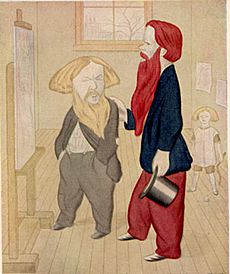
Ford Madox Brown was the grandson of a doctor named John Brown. His family did not have much money. They moved often between Calais, France, where he was born, and Kent, England.
Even though he didn't go to a regular school much, Ford showed a lot of talent for art. He loved copying old master prints. His father first wanted him to join the navy, but Ford's artistic skills were clear.
In 1835, his family moved to Bruges so he could study art at an academy. He continued his art studies in Ghent and then in Antwerp. He kept studying in Antwerp even after his mother and sister passed away. His father also died in 1842.
Famous Paintings
Ford Madox Brown's early works were admired by a young artist named Dante Gabriel Rossetti. Rossetti even asked Brown to be his teacher. Through Rossetti, Brown met other artists who started the Pre-Raphaelite Brotherhood.
Even though he was close to them, Brown was never an official member of the group. However, he started using their style. This meant using bright colors and painting things in a very realistic way. He was also influenced by other European artists he met during his travels.
In the 1850s, Brown found it hard to sell his paintings. He even thought about moving to India. But then, in 1852, he began working on two of his most important paintings.
One of his most well-known paintings is The Last of England. He painted it between 1852 and 1855. It shows a sad couple on a ship, leaving England forever. This painting was inspired by a friend, a sculptor named Thomas Woolner, who moved to Australia. The husband and wife in the painting are actually portraits of Brown and his second wife, Emma.
Brown's most important painting is Work (1852–1865). He started it in 1852 and showed it at his own art show in 1865. In this painting, Brown wanted to show all parts of life in Victorian England. It shows construction workers digging up a road. This scene also shows how old social classes were changing.
The painting is full of small details, showing different types of people and their roles in the city. Brown even wrote a detailed explanation for Work to go with his exhibition. He cared about the social issues in his painting. He even opened a soup kitchen and tried to help people find jobs in Manchester.
Brown found people in northern England who bought his art. He became frustrated with how his art was received at the Royal Academy. So, he stopped showing his work there. In 1858, he helped start the Hogarth Club with other artists like William Morris and Edward Burne-Jones.
From the 1860s, Brown also designed furniture and stained glass. He was one of the founders of William Morris's design company, Morris, Marshall, Faulkner & Co.
After Work, Brown's biggest project was The Manchester Murals. These were twelve large paintings for the Great Hall of Manchester Town Hall. They tell the story of the city's history. Brown was 72 years old when he finished these murals. They took him six years to complete and were his last major artwork.
Family Life
Ford Madox Brown was married two times. His first wife was Elizabeth Bromley, who was his cousin. They got married in 1841. Their first child died very young. Their daughter, Emma Lucy, was born in 1843.
His wife Elizabeth became very sick with a lung illness (tuberculosis). They traveled to Rome hoping it would help, but she passed away in Paris in 1846 at age 27. She was buried in Highgate Cemetery.
Emma Hill often modeled for Brown's paintings starting in 1848. She is the wife in The Last of England. She became his partner, and they had a daughter named Catherine Emily in 1850. They married in 1853.
Their son, Oliver Madox Brown (1855–1874), was very talented as both an artist and a writer. Sadly, he died young from a serious infection. This was a very sad time for Brown. Another son, Arthur, was born in 1856 but died when he was only ten months old.
His daughters, Lucy Madox Brown and Catherine Madox Brown, also became good artists. Lucy married William Michael Rossetti, who was Dante Gabriel Rossetti's brother. Catherine married Francis Hueffer. Through Catherine, Ford Madox Brown was the grandfather of a famous novelist, Ford Madox Ford.
Later Years and Death
Brown's second wife, Emma, passed away in 1890. Ford Madox Brown himself died in London in 1893. He is buried in the St Pancras and Islington Cemetery.
Legacy
A J D Wetherspoon pub in Manchester is named "The Ford Madox Brown" after him. This shows how his art and life are still remembered today.
Gallery
- Ford Madox Brown's works
-
The French saint King Louis IX in the stained glass of the East window of All Saints Church, Cambridge
-
Chaucer at the Court of Edward III, oil on canvas painting by Ford Madox Brown, 1847–1851, Art Gallery of New South Wales
-
Brown's Jacob and Joseph's Coat at Museo de Arte de Ponce, Ponce, Puerto Rico
-
King Rene's Honeymoon, 1864, an imaginary scene in the life of the art-loving medieval king René of Anjou.
Images for kids
-
Ford Madox Brown, 1867, drawn by Dante Gabriel Rossetti
See also
 In Spanish: Ford Madox Brown para niños
In Spanish: Ford Madox Brown para niños
- List of paintings by Ford Madox Brown
- British art
- English art


